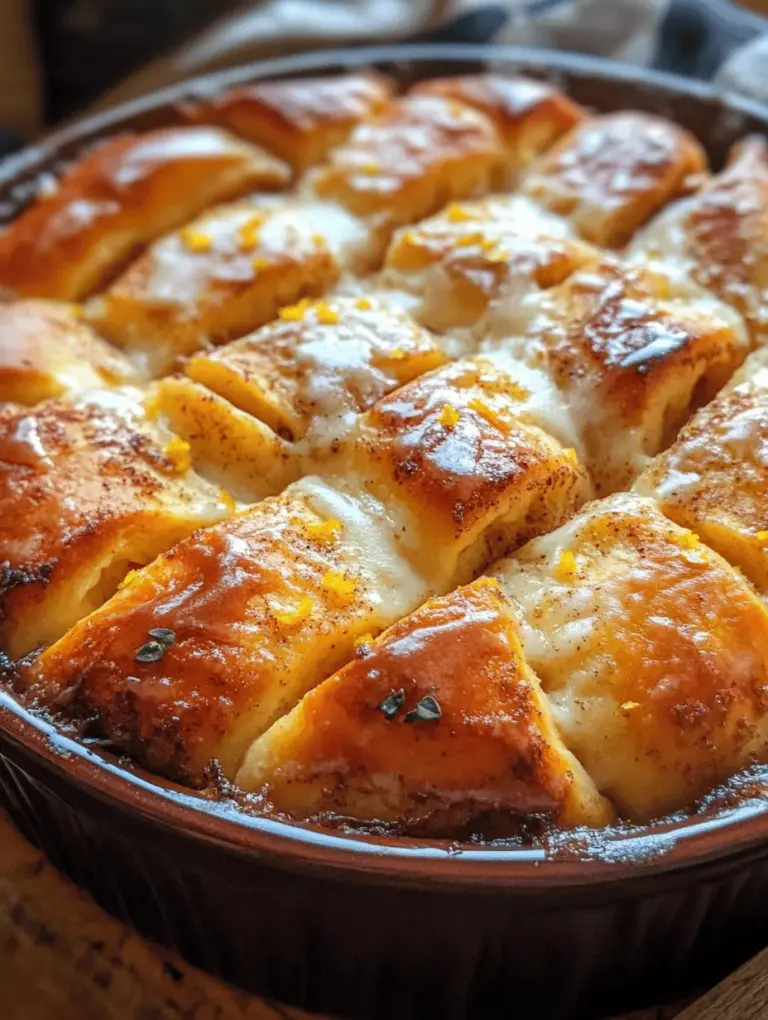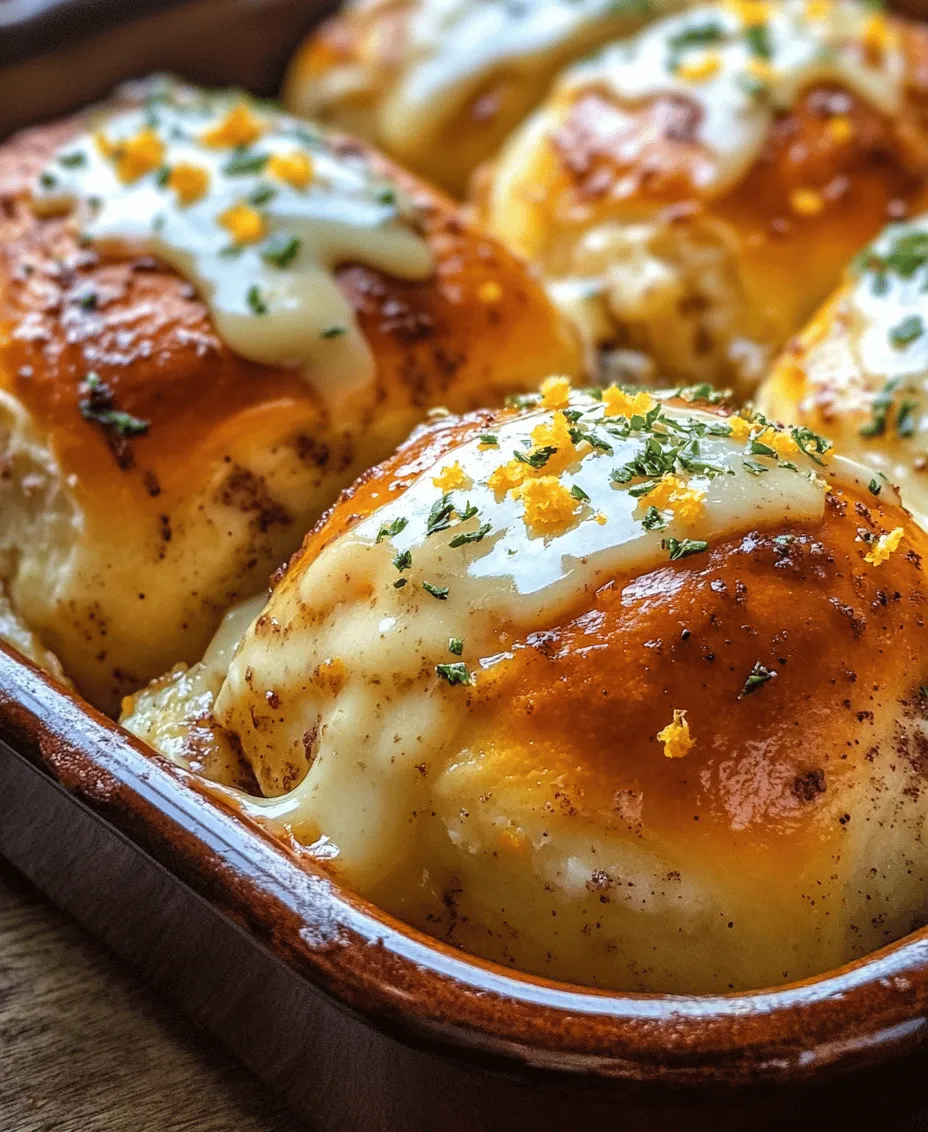Introduction
When it comes to comfort food, few things can compete with the warm, inviting scent of freshly baked goods wafting through the kitchen. Among these, Zesty Orange Rolls stand out as a delightful treat that perfectly marries the richness of a classic cinnamon roll with the bright, refreshing flavors of citrus. This recipe is not just about enjoying a sweet roll; it’s an experience that elevates your taste buds and fills your home with a sense of warmth and nostalgia.
The vibrant essence of orange brings a new dimension to the traditional roll, making it an ideal choice for breakfast, brunch, or even as a sweet afternoon snack. The addition of a warm sour cream butter glaze takes these rolls to the next level, introducing a creamy, tangy finish that complements the sweetness of the dough and the zestiness of the orange. It’s a combination that promises to awaken your senses and leave you wanting more.
The Allure of Zesty Orange Rolls
Zesty Orange Rolls are more than just a delightful treat; they embody a perfect balance of flavors and textures that can brighten anyone’s day. The fluffy, yeast-leavened dough is enriched with the natural sweetness of oranges, while the filling provides a warm hug of cinnamon and brown sugar, creating a harmonious blend that is both comforting and invigorating. Each bite reveals layers of flavor, with the bright notes of fresh orange zest dancing alongside the rich, buttery goodness of the roll itself.
Historically, orange rolls have made their mark in various cultures, often appearing on special occasions or as part of festive meals. In many households, they are a cherished recipe passed down through generations, symbolizing warmth, family gatherings, and the joy of sharing good food. Perhaps you have fond memories of enjoying these rolls at a family brunch or holiday celebration, where they were the centerpiece of the table, enticing everyone with their inviting aroma. Sharing these rolls with loved ones often creates moments of joy and connection, making them a beloved staple in many kitchens.
Understanding the Ingredients
Creating the perfect Zesty Orange Rolls begins with understanding the key ingredients and their roles in the recipe. Each component contributes essential qualities that come together to produce a soft, flavorful treat.
All-Purpose Flour
All-purpose flour is the cornerstone of the dough, providing the necessary structure and texture. The gluten formed during mixing and kneading gives the rolls their chewiness while allowing them to rise beautifully. When using flour, it’s crucial to measure accurately, as too much can lead to dry rolls, while too little can result in a dough that doesn’t hold its shape.
Active Dry Yeast
Active dry yeast is the magic ingredient that brings your dough to life. It ferments the sugars present in the flour, producing carbon dioxide gas that causes the dough to rise. This transformation results in the airy, fluffy texture that makes Zesty Orange Rolls so delightful. Ensuring the yeast is fresh and properly activated before mixing it into the dough is essential for optimal rise and flavor.
Whole Milk and Unsalted Butter
Whole milk and unsalted butter contribute richness and moisture to the rolls. The fat from the butter enhances the flavor while creating a tender crumb, while the milk adds moisture, helping the dough come together smoothly. Using room temperature butter ensures it can be easily incorporated into the dough, creating a uniform mixture that guarantees even baking.
Fresh Orange Zest
Fresh orange zest is the star of the show, providing a bright, zesty flavor that elevates the rolls. The zest contains essential oils that capture the essence of the fruit, making it a key ingredient in delivering that signature orange flavor. Using fresh zest rather than bottled extracts is crucial for achieving the most vibrant taste. The zest not only enhances the flavor profile but also adds a pop of color to the filling and glaze.
Importance of Freshness in Ingredients
Using high-quality, fresh ingredients is vital for achieving the best results in baking. Fresh flour, newly activated yeast, and ripe oranges can significantly impact the flavor and texture of your rolls. When preparing your Zesty Orange Rolls, take the time to ensure that each ingredient is fresh and of good quality. This attention to detail will reward you with rolls that are not only delicious but also a joy to share with family and friends.
Step-by-Step Guide to Making Zesty Orange Rolls
Now that you understand the role of each ingredient, it’s time to dive into the step-by-step process of making Zesty Orange Rolls. Follow these detailed instructions to create a batch of rolls that will impress anyone who tries them.
Preparing the Dough
1. Combine Dry Ingredients: In a large mixing bowl, combine the all-purpose flour, sugar, salt, and active dry yeast. Whisk them together to ensure an even distribution of the yeast and salt, which is crucial for the dough’s rise.
2. Mix Wet Ingredients: In a separate bowl, warm the whole milk until it’s just above body temperature, about 110°F (43°C). This temperature is optimal for activating the yeast without killing it. Add the room temperature unsalted butter to the warm milk and stir until melted.
3. Combine Mixtures: Pour the wet ingredients into the dry mixture. Add the fresh orange zest at this stage, ensuring that it’s evenly distributed throughout the mixture. Stir until a shaggy dough begins to form.
Tips for Achieving the Right Dough Consistency
The dough should be slightly sticky but manageable. If the mixture is too dry, add a tablespoon of warm milk at a time until you reach the desired consistency. Conversely, if it’s too wet, add more flour in small increments.
Kneading Techniques
4. Knead the Dough: Transfer the dough onto a lightly floured surface. Begin kneading the dough by folding it over itself and pushing it away with the heel of your hand. Turn the dough a quarter turn and repeat this process for about 8-10 minutes.
5. Signs That the Dough is Ready for Rising: The dough should become smooth and elastic, bouncing back when gently poked. If it feels overly tacky, sprinkle a little more flour on the work surface and continue kneading until the right texture is achieved.
Preparing the Filling
While the dough is rising, it’s time to prepare the filling that will add a burst of flavor to your orange rolls.
1. Combine Filling Ingredients: In a small bowl, mix together brown sugar, ground cinnamon, and the remaining fresh orange zest. This combination will create a sweet and aromatic filling that complements the rolls beautifully.
2. Butter Preparation: Ensure that the unsalted butter for the filling is at room temperature. Softened butter spreads easily, allowing it to blend seamlessly with the sugar and zest mixture. If the butter is too hard, you can microwave it for a few seconds to soften it, but avoid melting it completely, as you want it to spread evenly over the rolled-out dough.
These initial steps set the foundation for creating the perfect Zesty Orange Rolls. The combination of fresh ingredients, careful preparation, and attention to detail will reward you with a batch of rolls that are not only visually appealing but also bursting with flavor. In the next part of this article, we will delve into the rolling, cutting, and baking processes, ensuring you achieve rolls that are fluffy and delicious. Stay tuned for a delightful continuation of this culinary journey!
Rolling and Shaping the Rolls
Rolling and shaping the rolls are crucial steps in creating the perfect zesty orange rolls. To achieve an even thickness, start by lightly flouring your work surface and your rolling pin. Divide the dough into manageable sections if you find it too large to handle. Aim for a rectangle shape, approximately 1/4 inch thick. This uniformity will ensure that the rolls bake evenly.
When spreading the filling—a delightful mix of orange zest, sugar, and butter—be cautious not to over-saturate the dough. Apply the filling evenly across the surface, leaving about an inch of space along the edges. This technique prevents the filling from seeping out during the rolling process. Use a spatula or the back of a spoon to spread the filling, ensuring it adheres well to the dough.
Once the filling is in place, it’s time to roll the dough into a log. Gently lift the edge of the dough nearest to you and begin rolling it away from you, keeping the log tight yet not overly constricted. A tight roll helps maintain the spiral shape of the rolls, which enhances both aesthetics and texture. When you reach the end of the dough, pinch the seam to seal it securely.
Now that you have your log, it’s time to cut the rolls. Use a sharp knife or a piece of unflavored dental floss to slice the log into 1 to 1.5-inch pieces. This method ensures clean cuts without squishing the dough. Arrange the rolls in a greased baking dish, leaving space between each for expansion during the rising process.
The Rising Process
After shaping, the rolls need time to rise. This second rise is critical as it allows the dough to develop flavor and texture. Ideally, place the rolls in a warm, draft-free area. A slightly heated oven (turned off) or a warm kitchen can provide the perfect environment. Cover the dish with a clean kitchen towel to retain moisture.
The ideal conditions for dough rising include a temperature of around 75-80°F (24-27°C) and moderate humidity. This environment encourages yeast activity, resulting in fluffy, airy rolls. Allow the rolls to rise until they double in size, which typically takes 30 to 45 minutes. Keep an eye on them; if they seem to be rising too quickly, you can reduce the warmth of the environment.
Baking to Perfection
The baking process is where your zesty orange rolls transform from dough into delightful treats. Preheat your oven to 350°F (175°C) for at least 15 minutes before placing the rolls inside. A properly preheated oven is essential for even baking and helps achieve that golden-brown exterior.
Indicators of doneness for your orange rolls include a beautiful golden color on top and a slight firmness when gently pressed. You can also check the internal temperature; it should read about 190°F (88°C) when fully baked. Once the rolls are out of the oven, allow them to cool in the pan for about 10 minutes before glazing. This cooling time is crucial, as glazing warm rolls ensures that the glaze seeps into the nooks and crannies, enhancing the flavor.
Creating the Warm Sour Cream Butter Glaze
The warm sour cream butter glaze is the finishing touch that elevates your orange rolls. To create this glaze, you will need sour cream, unsalted butter, powdered sugar, and a splash of vanilla extract. Begin by melting the butter in a saucepan over low heat, then remove it from the heat once fully melted.
In a mixing bowl, combine the melted butter and sour cream, whisking until smooth. Gradually add the powdered sugar while continuing to whisk, ensuring there are no lumps. If the glaze is too thick, add a little milk or cream until you reach your desired consistency. Aim for a pourable glaze that will coat the rolls nicely without being too runny.
When glazing the rolls, drizzle the warm glaze over the top using a spoon or a small pitcher. For even coverage, consider pouring the glaze in a circular motion, allowing it to pool slightly in the center. The warmth of the rolls will help the glaze to melt slightly, creating a deliciously sweet crust.
Serving Suggestions
Zesty orange rolls are perfect for a variety of occasions, especially brunches, holidays, or casual gatherings. They pair wonderfully with a range of beverages like freshly brewed coffee, herbal teas, or a light sparkling beverage. These rolls can also complement savory dishes, such as eggs benedict or a charcuterie board, making them versatile for any meal.
When it comes to presentation, consider serving your rolls on a beautiful platter or tiered stand. Garnish with a sprinkle of powdered sugar or additional orange zest for an extra pop of color. You might also place a small bowl of additional glaze on the side for guests who desire an extra drizzle.
Nutritional Information
Understanding the nutritional aspects of your zesty orange rolls can be beneficial, especially if you’re mindful of dietary restrictions. Each roll contains carbohydrates, sugars, and fats, primarily from the dough and glaze. A single roll generally has around 250-300 calories, depending on the size and amount of glaze used.
For those with dietary restrictions, consider making substitutions to cater to different needs. For a lighter version, you can substitute Greek yogurt for sour cream in the glaze. Additionally, using whole wheat flour instead of all-purpose flour can add fiber to the recipe. Vegan alternatives can also be explored by using plant-based butter and non-dairy yogurt.
Conclusion
Baking zesty orange rolls with a warm sour cream butter glaze is not just about creating a delicious treat; it’s an experience that brings comfort and joy. The process of mixing, rolling, and glazing allows you to engage creatively in the kitchen, while the delightful aroma wafting through your home will captivate everyone around.
These rolls are more than just a recipe; they can become a family tradition, a staple at gatherings, or a comforting breakfast treat. As you savor the first bite of your homemade zesty orange rolls, you’ll appreciate the effort put into making them. We encourage you to explore baking as a creative outlet, experiment with flavors, and share your creations with loved ones. Whether enjoyed alone or with family and friends, these rolls are sure to bring cheer and warmth to any occasion.



